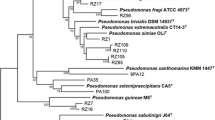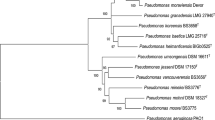Abstract
Nineteen efficient phosphate-solubilizing fluorescent Pseudomonas from the cold deserts of the trans-Himalayas were screened for stress tolerance against temperature, alkalinity, salinity, calcium salts, and desiccation. Phylogenetic analysis based on 16S rRNA gene sequencing placed these bacteria under three groups with fourteen strains in Group I including Pseudomonas trivialis and P. poae, two strains in Group II together with Pseudomonas kilonensis and P. corrugata, and three strains in Group III along with Pseudomonas jessenii and P. moraviensis. Genetic diversity assessed by ERIC and BOX-PCR revealed variability among strains belonging to the same phylogenetic groups. Cluster analysis based on the growth characteristics under regimes of different stress levels placed the strains into three distinct clusters displaying no correlation to their phylogenetic groups. Stress-tolerant strains differed in the level of decline in phosphate solubilization under increasing intensity of various stress parameters. The highest decrease occurred with 5% CaCO3, followed by 2.5% CaCO3, pH 11, 5% NaCl, temperature of 37°C, 40% PEG, 5% CaSO4, 2.5% NaCl, 2.5% CaSO4, pH 9 and temperature of 15°C. Two strains belonging to Phylogenetic Group I exhibited higher phosphate solubilization at lower temperature. The results revealed that stress-tolerance ability was not limited to any particular phylogenetic group. Knowledge about the genetic variants of phosphate-solubilizing fluorescent Pseudomonas with potential for tolerance to desiccation, alkalinity, temperature, and salinity could be useful in understanding their ecological role under stressful environments of low phosphate availability.





Similar content being viewed by others
References
Asea PEA, Kucey RMN, Stewart JWB (1988) Inorganic phosphate solubilization by two Penicillium species in solution culture and soil. Soil Biol Biochem 20:459–464
Arun AB, Sridhar KR (2005) Growth tolerance of rhizobia isolated from sand dune legumes of the Southwest coast of India. Eng Life Sci 5:134–138
Botelho GR, Mendonça-Hagler LC (2006) Fluorescent pseudomonads associated with the rhizosphere of crops-an overview. Braz J Microbiol 37:401–416
Carrow R, Waddington D, Rieke P (2001) Turfgrass soil fertility and chemical problems. Ann Arbor, Chelsea, MI
Chenna R, Sugawara H, Koike T, Lopez R, Gibson TJ, Higgins DG, Thompson JD (2003) Multiple sequence alignment with the CLUSTAL series of programs. Nucleic Acids Res 31:3497–3500
Chikthimmah N, Laborde LF, Beelman RB (2005) Hydrogen peroxide and calcium chloride added to irrigation water as a strategy to reduce bacterial populations and improve quality of fresh mushrooms. J Food Sci 70:273–278
Douka CE, Apostalakis CG, Skarloy VD (1978) Studies of Rhizobium meliloti isolated from salt-affected soil. Ann Appl Biol 88:457–460
Glick BR (1995) The enhancement of plant growth by free living bacteria. Can J Microbiol 41:109–117
Gulati A, Rahi P, Vyas P (2008) Characterization of phosphate-solubilizing fluorescent pseudomonads from rhizosphere of seabuckthorn growing in the cold deserts of Himalayas. Curr Microbiol 56:73–79
Hua SST, Tsai V, Lichens GM, Noma AT (1982) Accumulation of amino acids in Rhizobium spp WR 10001 in response to sodium chloride salinity. Appl Environ Microbiol 44:135–140
Jackson ML (1973) Soil chemical analysis. Prentice Hall, New Delhi
Johri JK, Surande S, Nautiyal CS (1999) Occurrence of salt, pH, and temperature-tolerant, phosphate-solubilizing bacteria in alkaline soils. Curr Microbiol 39:89–93
Kaschuk G, Hungria M, Andrade DS, Campo RJ (2006) Genetic diversity of rhizobia associated with common bean (Phaseolus vulgaris L.) grown under no-tillage and conventional systems in Southern Brazil. Appl Soil Ecol 32:210–220
Kimura M (1980) A simple method for estimating evolutionary rates of base substitutions through comparative studies of nucleotide sequences. J Mol Evol 16:111–120
Kulkarni S, Nautiyal CS (2000) Effects of salt and pH stress on temperature-tolerant Rhizobium sp. NBRI1330 nodulating Prosopis juliflora. Curr Microbiol 40:221–226
Latour X, Corberand T, Laguerre G, Allard F, Lemanceau P (1996) The composition of fluorescent pseudomonad population associated with roots is influenced by plant and soil type. Appl Environ Microbiol 62:2449–2456
Louws FJ, Fulbright DW, Stephens CT, de Bruijn FJ (1994) Specific genomic fingerprints of phytopathogenic Xanthomonas and Pseudomonas pathovars and strains generated with repetitive sequences and PCR. Appl Environ Microbiol 60:2286–2295
Miller KJ, Woods JR (1996) Osmoadaptation by rhizosphere bacteria. Annu Rev Microbiol 50:101–136
Mnasri B, Mrabet M, Laguerre G, Aouani M, Mhamdi R (2007) Salt-tolerant rhizobia isolated from a Tunisian oasis that are highly effective for symbiotic N2-fixation with Phaseolus vulgaris constitute a novel biovar (bv. Mediterranense) of Sinorhizobium meliloti. Arch Microbiol 187:79–85
Nakamura I, Ogimoto K, Izumi H (1996) Influence of calcium concentration on the antimicrobial activity of lasalocid against Selenomonas ruminantium. J Vet Med Sci 58:755–759
Nautiyal CS, Bhadauria S, Kumar P, Lal H, Mondal R, Verma D (2000) Stress induced phosphate solubilization in bacteria isolated from alkaline soils. FEMS Microbiol Lett 182:291–296
Pal SS (1998) Interactions of an acid tolerant strain of phosphate solubilizing bacteria with a few acid tolerant crops. Plant Soil 198:169–177
Rademaker JLW, Louws FJ, De Bruijn FJ (1997) Characterization of the diversity of ecologically important microbes by rep-PCR genomic fingerprinting. In: Akkermans ADL, Van Elsas JD, De Bruijn JD (eds) Molecular microbial ecology manual, chap 3.4.3. Kluwer, Dordrecht, pp 1–26
Rangarajan S, Loganathan P, Saleena LM, Nair S (2001) Diversity of pseudomonads isolated from three different plant rhizospheres. J Appl Microbiol 91:742–749
Rangarajan S, Saleena LM, Nair S (2002) Diversity of Pseudomonas spp. isolated from rice rhizosphere populations grown along a salinity gradient. Microb Ecol 43:280–289
Rehman A, Nautiyal CS (2002) Effect of drought on the growth and survival of the stress-tolerant bacterium Rhizobium sp. NBRI2505 sesbania and its drought-sensitive transposon n5 mutant. Curr Microbiol 45:368–377
Sharan A, Shikha DNS, Gaur R (2008) Xanthomonas campestris, a novel stress tolerant, phosphate-solubilizing bacterial strain from saline-alkali soils. World J Microbiol Biotechnol 24:753–759
Singh RP, Gupta MK (1990) Soil and vegetation study of Lahaul and Spiti cold desert of Western Himalayas. Indian For 116:785–790
Tacao M, Alves A, Saavedra MJ, Correia A (2005) BOX-PCR is an adequate tool for typing Aeromonas spp. Antonie Van Leeuwenhoek 88:173–179
Tran H, Kruijt M, Raaijmakers JM (2008) Diversity and activity of biosurfactant-producing Pseudomonas in the rhizosphere of black pepper in Vietnam. J Appl Microbiol 104:839–851
Versalovic JSM, de Bruijn FJ, Lupski JR (1994) Genomic fingerprinting of bacteria using repetitive sequence-based polymerase chain reaction. Methods Mol Cell Biol 5:25–40
Vriezen JAC, de Bruijn FJ, Nusslein K (2006) Desiccation responses and survival of Sinorhizobium meliloti USDA 1021 in relation to growth phase, temperature, chloride and sulphate availability. Lett Appl Microbiol 42:172–178
Vyas P, Rahi P, Chauhan A, Gulati A (2007) Phosphate solubilizing potential and stress tolerance of Eupenicillium parvum from tea soil. Mycol Res 111:931–938
Yang HH, Vinopal RT, Grasso D, Smets BF (2004) High diversity among environmental Escherichia coli isolates from a bovine feedlot. Appl Environ Microbiol 70:1528–1536
Zahran HH (1999) Rhizobium legume symbiosis and nitrogen fixation under severe conditions and in arid climate. Microbiol Mol Biol Rev 63:968–989
Acknowledgment
The authors acknowledge the Director, Institute of Himalayan Bioresource Technology for providing the necessary facilities. Thanks are also due to Mr. Digvijaya Singh Naruka for the technical support in operating the DNA Sequencer. The financial support by the Council of Scientific and Industrial Research under the CSIR Network Project “Exploitation of India’s Rich Microbial Diversity” is also acknowledged.
Author information
Authors and Affiliations
Corresponding author
Rights and permissions
About this article
Cite this article
Vyas, P., Rahi, P. & Gulati, A. Stress Tolerance and Genetic Variability of Phosphate-solubilizing Fluorescent Pseudomonas from the Cold Deserts of the Trans-Himalayas. Microb Ecol 58, 425–434 (2009). https://doi.org/10.1007/s00248-009-9511-2
Received:
Accepted:
Published:
Issue Date:
DOI: https://doi.org/10.1007/s00248-009-9511-2




